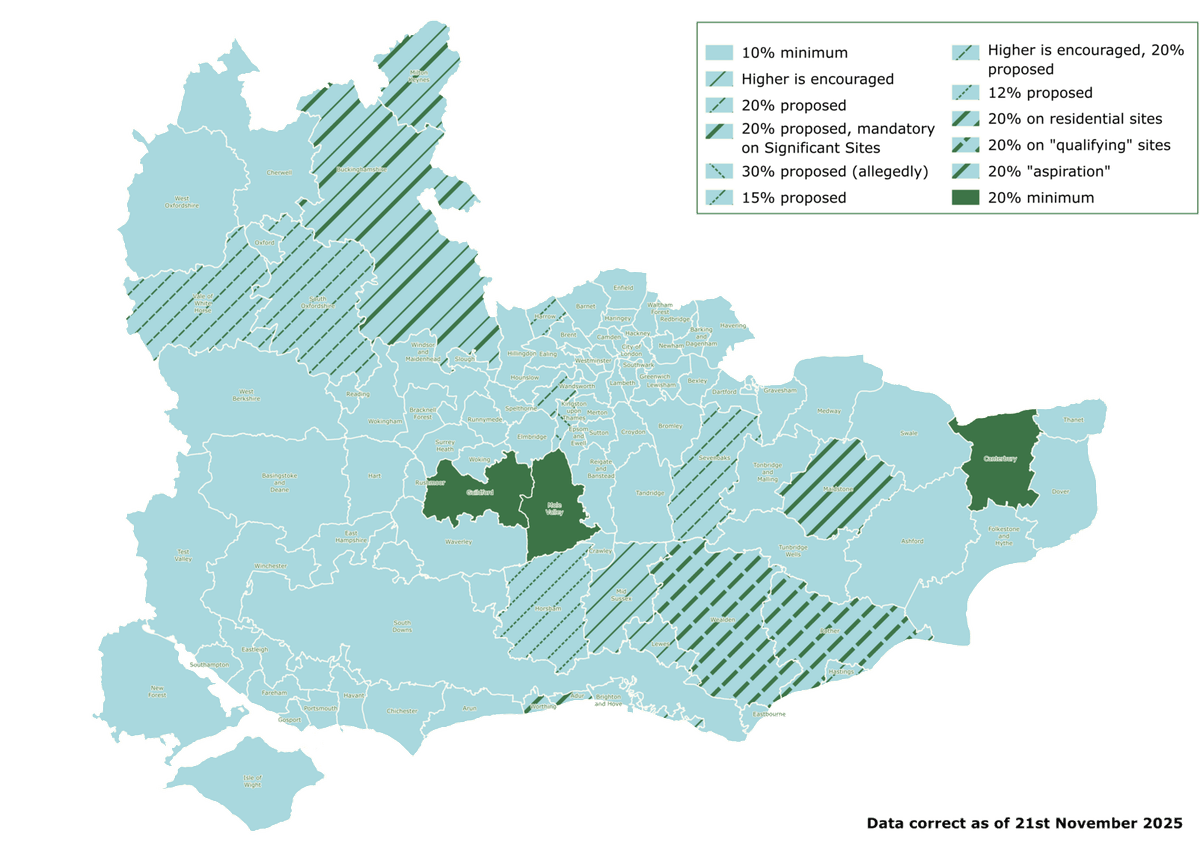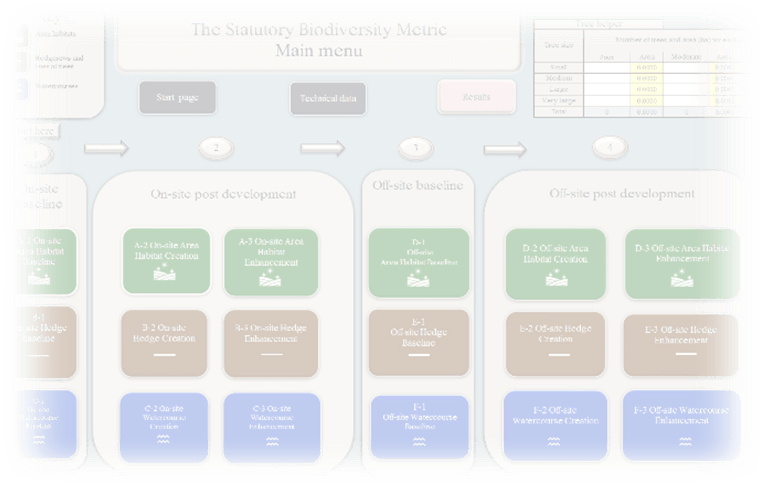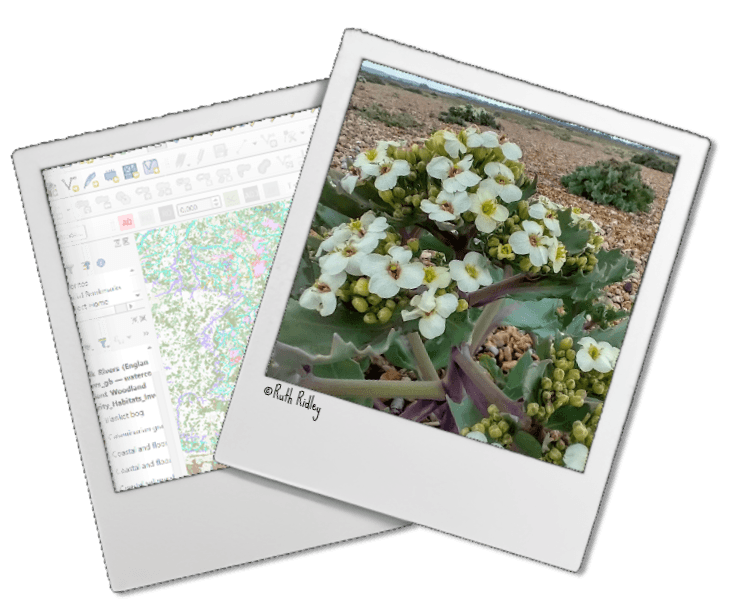


What Is It?
Biodiversity Net Gain (BNG) is an ecological assessment which quantifies the baseline “value” of a site and compares it with the post-development “value”. It was made mandatory in 2024 for the majority of planning submissions, with a national minimum requirement of 10% gain.
The official overview is available from the Department for Environment, Food & Rural Affairs (DEFRA).
What Net Gain Do I Need?
Although the national minimum is 10%, some Local Planning Authorities (LPAs) have set their own higher thresholds. Have a look at the map below to see what your current (and upcoming) LPA minimum gain is:

Is My Project Exempt?
A small number of developments do not require a BNG assessment. The most common types are:
- All planning applications (or variations of existing applications) that were submitted BEFORE 12th February 2024
- Proposals which do not impact a Priority Habitat, and impact LESS than 25m2 or 5m of on-site habitats (known as the de minimis exemption)
- Householder applications
- Developments consisting of nine or less dwellings which meet the self-build/custom definition AND are located on a site no larger than 0.5ha
- Planning permissions granted through a Special Development Order, INCLUDING permitted development
- Your architect or other planning consultant will be able to confirm if your planned works fall under any of these categories.

Other less common exemptions are shown below:
- Biodiversity gain sites, comprising off-site habitat creation/enhancements to offset another development
- Any works forming part of (or ancillary to) the HS2 ONLY high-speed rail network
- Works on Crown land
Obtaining Your Baseline
To conduct a BNG assessment, a site visit from a suitably experienced ecologist is necessary. These usually take the form of a Preliminary Ecological Appraisal (PEA) field survey, which will identify evidence of protected species or any other ecological constraints in addition, with an accompanying Habitat Condition Assessment (HCA) and/or River Condition Assessment (RCA) to obtain a condition score for each habitat onsite. Once the field surveys are complete, the habitats are mapped using Geographic Information Systems (GIS) software, which generates areas and/or lengths for each parcel.
If your site contains an Irreplaceable Habitat (such as Ancient Woodland), it cannot be assessed by standard BNG methods. These habitats generate zero habitat units and therefore cannot be removed or enhanced. We recommend leaving them out of any red line boundaries where possible but if there is a strong reason why they MUST be included, any impacts will require bespoke compensation in ADDITION to any BNG mitigation.

INSET: What Is An RCA?
If your site contains a watercourse, or is within 10m of one, you will need an additional field survey known as a River Condition Assessment (RCA). These work in a similar way to the habitat condition surveys, but with assessment criteria specific to rivers and streams.
These surveys can only be conducted by accredited River Condition Assessors, like yours truly!
Effective mitigation for watercourses can be tricky, so we would usually recommend designing your plans to avoid them.
Calculating Your Net Gain
A similar mapping exercise is undertaken for the proposed development so that a second set of areas and/or lengths are created. Both of these sets of measurements are entered into the Statutory Metric calculation tool, along with other variables such as Strategic Significance. Once all the data is captured, the metric performs a series of calculations to assess whether your proposals will result in a gain or a loss.
However, bear in mind that a gain doesn’t automatically mean the development has successfully passed!
The metric also groups habitats into Distinctiveness categories. If your proposals result in a discrepancy (for example; if Low distinctiveness habitats are being created when Medium distinctiveness habitats are being lost), this results in a habitat trading deficit. This deficit will also need to be balanced in ADDITION to achieving an overall net gain.

What If I Can't Reach The Target?
Sometimes, a development just can’t achieve the right net gain. This is common and can happen for a variety of reasons, often due to restricted space on site or difficulties in ongoing management. For these sites, there are three different approaches we can explore:
OPTION 1 - OFF-SITE
The simplest way is to look at using an off-site land parcel, preferably owned by you or at least nearby. The LPA will usually look more favourably on a site that relatively local but if you have a larger plot of land elsewhere, there may be scope to enhance that instead.
OPTION 2 - HABITAT BANKING
If this isn’t possible, the next option is purchasing biodiversity units from a habitat bank. This is a growing market with no definitive register yet, but you can speak with a dedicated broker, contact individual habitat banks yourself, or even investigate whether your LPA offers units for sale. Each habitat unit comes with a different cost, and often they can be purchased in quantities as small 0.25 of a unit. We will be happy to recommend habitat banks and/or brokers who we currently work with if required.
Your ecologist will tell you exactly how many units you need to purchase. Be aware though that a Spatial Risk Multiplier (SRM) is applied within the metric, which means that units from banks that are further away from you will be need to be purchased in a proportionally larger quantity! It's always best to shop locally if you can.
OPTION 3 - STATUTORY CREDITS
The final route is known as Statutory Credits, which are purchased through a government portal. These should be considered only a “last resort” but if you DO need to use them, you will need to provide proof that all other routes were investigated first. The number that need to be purchased is based on the unit shortfall tab of the metric, which contains values separated by tier, rather than Distinctiveness. These credits are considerably more expensive and are only worth half of a biodiversity unit, so we would recommend avoiding these if at all possible!
Once the compensation method is confirmed, the LPA will require the following to be submitted with planning:
- a baseline ecological survey report, such as a PEA or an Ecological Impact Assessment (EcIA)
- a draft Biodiversity Gain Plan (BGP)
- the Statutory Metric calculation tool
- HCA sheets for the baseline AND proposed habitat conditions
- site and soft landscaping plans
- supplemental documents, depending on the outcome of the BNG assessment

What To Expect After Your Project Is Approved
When you receive approval, there will be a condition asking for a document known as a Habitat Managementand Monitoring Plan (HMMP) to be submitted, along with a final version of your BGP. The HMMP provides detailed information on the proposed habitat protection, enhancement, and creation measures. It also outlines the habitat management and a monitoring schedule covering the full 30-year period (starting AFTER the development is complete).
As with most planning submissions, you will also likely have additional ecology-related conditions to discharge. These might include a Landscape and Ecology Management Plan (LEMP), Construction Environmental Management Plan (CEMP), Ecological Mitigation/Management Plan (EMP), lighting strategy for bats, or further reports following any pre-commencement surveys. These can be discharged at the same time as the HMMP and final BGP.
In addition, if you are using an off-site parcel of land for your mitigation measures, the parcel of land will need to be entered onto the national biodiversity gain sites register, and a Section 106 or othe rconservation covenant will need to be set up. If applicable, a proof of biodiversity unit or Statutory Credit purchase will need to be submitted to the LPA once the draft BGP is approved, with the documents all provided prior to works starting.
Following the completion of works, you will need to manage the habitats for a period of 30 years. Your ecologist will visit regularly to make sure all is well, and will advise you if they believe any actions are needed to maintain the habitat in the agreed condition.













